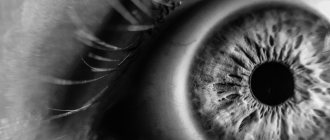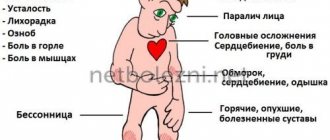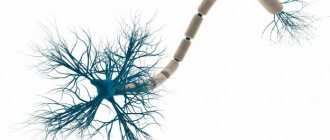The vessels of the brain form a complex circulatory system, which must ensure constant delivery of nutrients and oxygen to nerve cells.
The circle of Willis is a closed complex of arteries that provides blood supply to the structures of the central nervous system due to the redistribution of blood.
Pathologies in its structure and function lead to various neurological disorders. We will talk further about what the Circle of Willis is and what it means if it is open.
About the Circle of Willis of the brain
The circle of Willis protects the brain from hypoxia when blood flow through the arteries is impaired. Redistribution of blood helps prevent the death of neurons due to thrombosis, compression or rupture of blood vessels.
A closed circle system with anastomoses ensures normal blood flow due to the blood that flows through the vessels of the opposite side. An anastomosis is a small artery that connects two areas of the nervous system with separate blood supplies.
Anatomical structure
The vessels of the circle are located under the arachnoid membrane in the area of the optic chiasm at the base of the brain. In most people, several vessels are involved in the formation of the arterial circle:
- anterior communicating artery;
- posterior communicating arteries;
- left and right anterior cerebral arteries;
- left and right posterior cerebral arteries;
- supracuneiform part of the internal carotid artery.
All arteries connect with each other, forming a vascular heptagon. Due to this, anastomoses are formed between the carotid and basilar arteries. This makes it possible to prevent ischemic brain damage due to unilateral disturbances of blood flow through the vessels.
Functions
The main function of the arterial circle is to ensure normal blood supply to the brain in case of pathology of individual vessels. This is achieved due to its closed structure and constant blood flow through several arteries.
Functions
The circle of Willis forms two streams of arterial blood supply from the basilar basin and blood supply to the head from the basin of the carotid vascular system. The supply of those parts of the organ that do not receive additional nutrition is carried out through the functioning of one of the efficient channels.
The ring of Willis is located in the subarachnoid region of the base of the brain organ and is surrounded by arterial elements (formed by branches), which create the optic chiasm and the base of the midbrain.
Behind the VC is the pons organ, which connects the ring with the basilar vessel.
The vessels of the forebrain are well formed (in most cases) and according to standard indicators they have a lumen diameter of up to 2.5 millimeters. PSA has an identical diameter and length - up to 10.0 millimeters.
The diameter of the left-sided internal carotid vessel is according to the standard up to 1.0 millimeters.
The midbrain vessel has an asymmetrical shape - its left side is wider in diameter, and the right side has a narrowing of the lumen.
The vessels of the anterior section are distinguished by their high constancy in formation - these are the carotid and also the cerebral. The vessels of the posterior section are more variable and have a certain physiological individuality in the structural anatomy and branches of the ring of Willis.
With pathology of the forebrain bed, the clinical manifestations are much stronger and have a worse prognosis for the development of this pathology.
What pathologies are possible
The circle of Willis has a complex structure and consists of 10-12 arteries. Therefore, some people may have diseases associated with vascular damage. They are divided into two groups: congenital, which arose during intrauterine development of the fetus, and acquired, developing after birth. The most common pathologies are:
- Aneurysm is a local protrusion of the arterial wall outward. A person can go for a long time without any symptoms, which makes timely diagnosis difficult. If blood pressure increases, the aneurysm may rupture. In this case, an intracranial hematoma develops. The patient complains of headache, nausea, vomiting and dizziness. He experiences neurological disorders, including severe paralysis or death. Aneurysms can be located on any vessel;
- hypoplasia is characterized by underdevelopment of the artery with a decrease in its diameter and lumen. This leads to insufficient blood flow. If the circle is closed, then the disease is asymptomatic, since blood flows to the brain through other vessels;
- aplasia is complete underdevelopment of the artery. Can be observed in any vessel. Aplasia of the anterior or posterior communicating artery leads to the fact that the circle of Willis becomes open. This is fraught with the development of cerebral ischemia against the background of concomitant pathologies: atherosclerosis, aneurysms, thrombosis, etc.;
- trifurcation of the carotid artery with its splitting into three vessels. The condition is not manifested by any diseases, however, if the patency of the artery is impaired, cerebral ischemia is possible.
What do various options for the development of VC mean in practice?
The asymmetry of the structure of the VC leads to a significant asymmetry of blood flow and is an important factor in the development of intracranial aneurysms and ischemic strokes. These disorders typically occur in elderly patients in whom an open VC limits the ability to compensate for acute changes in the arterial blood supply to the brain.
Before the development of these diseases or their complications, a person does not even know that he has anomalies in the development of cerebral vessels.
Aneurysms of the VC vessels
An aneurysm is a protrusion of the vascular wall. Aneurysms of the vessels included in the VC are the most common cerebral aneurysms. Most often they arise in the ACA, at the bifurcation (bifurcation site) of the ICA and in the PCA, at the bifurcation of the BA.
Most brain aneurysms do not cause any symptoms until they rupture. However, with large protrusions, compression of nearby tissues of the central nervous system may occur, which in some people leads to:
- double vision;
- pupil dilation;
- pain behind the eyeballs;
- headaches.
When an aneurysm of the vessels entering the VC ruptures, hemorrhage develops in the space around the brain (subarachnoid hemorrhage), the symptoms of which include:
- Sudden onset of severe headache.
- Nausea and vomiting.
- Stiffness in the neck.
- Temporary loss of vision or consciousness.
Ischemic stroke with various variants of the VC structure
Disruption of the symmetry of blood flow through the arteries of the brain can contribute to the development of atherosclerotic lesions, which increases the risk of ischemic stroke. An open VC does not provide good collateral blood flow, so the size of the stroke may increase.
Symptoms of ischemic stroke:
- Sudden onset of numbness or weakness in the muscles of one side of the body.
- Sudden deterioration of consciousness, difficulty speaking or understanding speech.
- Sudden visual disturbances.
- Sudden disturbances in walking, dizziness, loss of balance and coordination of movements.
- Sudden onset of headache.
Is an open circle of Willis good or bad?
The structure of the arterial circle has many variations. Normally, it is closed, which helps protect nervous tissue from ischemia and damage.
In some people, the circle of Willis is not closed on the side of the anterior or posterior communicating artery. This condition is not always regarded by doctors as a pathology.
An open arterial circle is bad. In the absence of all anastomoses, a person has an increased risk of developing ischemia of nervous tissue against the background of atherosclerosis, thrombosis and arterial embolism.
However, the condition itself does not require treatment, since pathologies arise only against the background of concomitant diseases of the cardiovascular system.
Drug treatment of abnormalities
How to treat? If an anomaly is detected in the circle of Willis, drug treatment is aimed at preventing complications of pathologies that can cause this organ to function:
- To improve blood circulation in the head with pathology of the circle of Willis - nootropic drugs (Piracetam, as well as Nootropil);
- A group of vasodilator drugs - the drug Cinnarizine, Vestibo;
- A group of antispasmodic medications - Papaverine;
- Medicines that improve oxygen consumption in case of anomaly of the circle of Willis - Cerebrolysin, the drug Solcoseryl;
- Group of sedative drugs - Valerian;
- Statins for anomalies of the circle of Willis - the drug Atomax.
The circle of Willis is a system of blood flow in the brain, functions of which are reserved, therefore, when identifying pathologies such as aneurysm, thrombosis of arteries, surgical methods are used to treat the pathology.
Clinical manifestations
Violations of the structure of the circle and its openness lead to disruption of the blood supply to the brain. Depending on where ischemia develops, a person may develop different symptoms. The first symptoms are often:
- dizziness that occurs during severe physical or emotional stress;
- severe headache that does not disappear when taking painkillers;
- migraine attacks with nausea, vomiting, and fear of loud sounds and lights.
As anemia progresses, neurological disorders occur. The patient may complain of impaired sensitivity on the skin, decreased muscle strength or complete absence of movements in the arm or leg, frequent dizziness, etc. Cognitive functions are also impaired: the ability to remember information decreases, the patient takes a long time to make decisions, forgets the way home, etc. With ischemia frontal cortex, speech is impaired. The patient cannot speak clearly or does not perceive the speech of other people.
Diagnostic measures
Detection of an open arterial circle requires instrumental studies: angiography, Dopplerography, computed tomography or magnetic resonance imaging.
These methods allow you to visually assess the condition of the arterial vessels and identify their pathological changes. Only the attending physician should interpret the examination results.
Angiography
“Gold standard” for examination of cerebral vessels. Angiography allows you to assess the condition of blood vessels, detect aneurysms, narrowings and complete blockage of the lumen. The principle of the method is similar to radiographic studies. Radiocontrast agents are used only to identify blood vessels on images.
They are inserted through a small catheter into the artery. Contrast agents circulate along with the blood and are clearly visible on the resulting images. They are excreted from the body in the urine, without having a negative effect on internal organs. Modern angiography allows you to obtain a three-dimensional image of the arteries of the circle of Willis.
Dopplerography
The method is carried out simultaneously with ultrasound examination of cerebral vessels. Dopplerography allows you to evaluate the structure of the vessels of the circle of Willis and identify their anomalies. In this case, the doctor can examine the speed of blood flow.
Diagnostics
The examination is carried out under the supervision of a vascular surgery specialist. It is possible to involve a neurologist.
The measures are mostly standard; it is necessary to carefully evaluate the anatomical structure of the circle of Willis.
- Angiography. Essentially an x-ray with contrast. A special drug is introduced, which, accumulating in the blood, enhances the pattern. Then doctors take a series of photographs and, based on the results, evaluate the nature of the structure of the ring-shaped structure. It is considered an accessible and relatively simple diagnostic method with a minimum of contraindications.
- Dopplerography of cerebral vessels. Required to assess the speed and quality of blood flow in cerebral structures, used as part of a functional examination. Prescribed in all cases.
- MRI. To identify complex forms of anomaly. This is perhaps the most informative technique among others. Maximum safe, does not create a load on the body, and is not accompanied by pain. But the research costs on average more than its analogues. That’s why they resort to this method when others have failed.
- It is possible to prescribe invasive, selective angiography.
Activities can be adjusted during the examination and supplemented with other techniques. The issue is resolved at the discretion of the specialist.
Treatment approaches
If the arterial circle is not closed, special treatment is not required. Without accompanying changes in the blood vessels, people do not experience any symptoms of disease. Therapy should be aimed at preventing arterial pathologies and eliminating them.
For this, patients are prescribed a number of medications, and are also advised to adhere to a diet and change their lifestyle.
Non-drug approaches
All patients should adhere to medical recommendations regarding lifestyle:
- exercise regularly. To prevent vascular diseases, aerobic exercise is recommended: walking, jogging, cycling and swimming. Classes should be ongoing and suitable for the person’s level of physical fitness;
- eliminate bad habits: smoking and drinking alcohol;
- Avoid fatty, salty, fried and spicy foods in your diet. They contribute to the development of atherosclerosis and hypertension. Both conditions are often complicated by thrombosis, aneurysms and their rupture;
- It is recommended to eat more vegetables, fruits, berries, nuts and lean meats. They are rich in beneficial amino acids, vitamins, microelements and biologically active substances that have a positive effect on the condition of the cardiovascular system;
- Limiting salt intake to 5 g per day. If the patient has severe arterial hypertension, then the volume of consumption is reduced to 1 g;
- avoid stressful situations at work and in your personal life.
These recommendations reduce the risk of developing heart and vascular diseases by preventing pathological changes in the arterial circle of the brain.
Medicines
Medications are recommended for people with vascular pathology of the circle of Willis and accompanying changes in the arteries. Medicines of the following pharmacological groups can be used:
- drugs that improve cerebral circulation (Cerebrolysin, Cavinton, etc.). They normalize vascular tone and increase the intensity of blood flow in the arteries of the brain. This avoids ischemia and neurological disorders;
- nootropics – Phenotropil, Glycine, Nootropil, etc. They enhance metabolic processes in neurons and reduce their sensitivity to damaging factors. Requires long-term use over several months to obtain a therapeutic effect;
- antioxidants (Dihydroquercetin, Mexidol) protect nerve cells from damage, including toxic substances. The effect is achieved by blocking free forms of oxygen, which negatively affect the structures of neurons;
- antispasmodics (Drotaverine, Papaverine and their analogues) are prescribed for spastic changes in blood vessels. Allows you to dilate arteries and restore normal blood supply to the brain. They have only a symptomatic effect and do not affect the underlying disease;
- B vitamins, which stimulate the restoration of nerve tissue and neuron membranes. Used in courses in the form of intramuscular injections;
- To eliminate pain, non-steroidal anti-inflammatory drugs (Diclofenac, Nise, etc.) are prescribed. They are highly effective for any form of headache, except migraine.
All medications are prescribed only by a doctor. Medicines have contraindications, failure to comply with which may cause progression of the underlying disease or lead to the development of side effects.
Surgical treatment
In case of multiple blood flow disorders, the patient is prescribed surgical interventions. They may be associated with the creation of a shunt or mechanical expansion of the lumen of the arteries. A shunt is a bypass for blood flow, which is placed around a narrowed area, an area of hypo- or aplasia. Mechanical expansion of the vessel is carried out using a stent or ballooning.
Signs of abnormal structure
Clinical signs of underdeveloped VC occur only when the body has developed a serious pathology in the bloodstream system, which has led to insufficient blood flow to the brain cells:
- Atherosclerotic plaques have formed on the arteries;
- Thrombosis of arteries of various diameters;
- Entry into the artery of an embolus, which the blood flow transported from the left-sided ventricle, or the left-sided atrium;
- Coronary insufficiency, which leads to impaired blood flow;
- Pulmonary artery insufficiency also disrupts blood flow, and the brain does not receive the required amount of nutrients;
- Aneurysm of the cerebral arteries.
Symptoms of impaired blood flow due to anomalies of the circle of Willis
The symptoms of impaired blood circulation correspond to the cause of the pathology in the bloodstream system, as well as in the organs of the brain. With a developing stroke, the symptoms are characteristic of this pathology; with encephalopathy, there will be completely different symptoms.
Generalized symptoms of impaired blood supply to the brain:
- Severe dizziness;
- Severe pain in the head, which intensifies when changing the position of the head;
- Inability to think correctly - difficulties in the intellect;
- Reduced concentration on objects and situations;
- A sharp decrease in memory;
- Inattention;
- Cardiopalmus;
- Dyspnea;
- Panic attack;
- Photophobia:
- Irritability;
- Drowsiness;
- Fatigue of the body;
- Deviations in the visual organ - blurriness and blurriness of objects;
- Clogged eyeball, doubling of objects;
- Tinnitus, which sometimes intensifies when the auditory nerve reacts to increased sounds;
- Constant feeling of fatigue.









